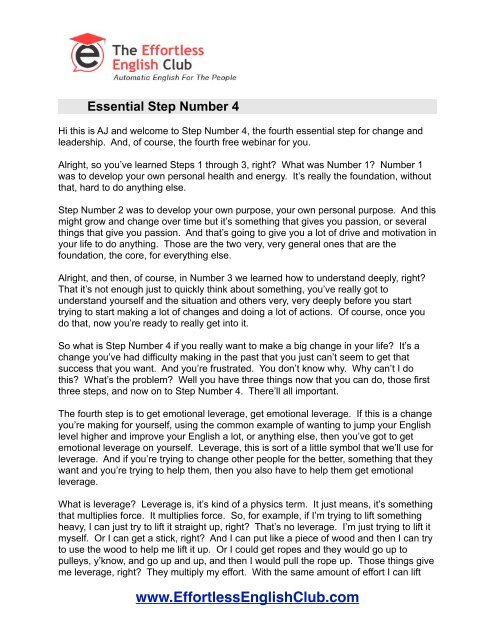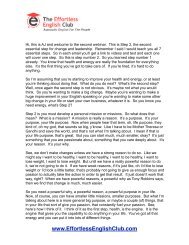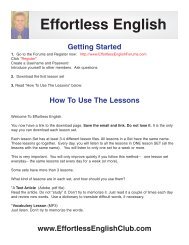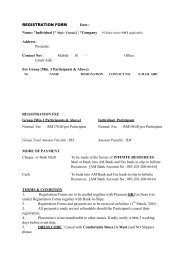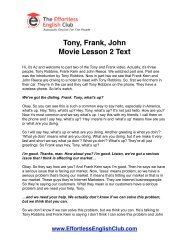Download The Text, Click Here - Effortless English
Download The Text, Click Here - Effortless English
Download The Text, Click Here - Effortless English
You also want an ePaper? Increase the reach of your titles
YUMPU automatically turns print PDFs into web optimized ePapers that Google loves.
Essential Step Number 4<br />
Hi this is AJ and welcome to Step Number 4, the fourth essential step for change and<br />
leadership. And, of course, the fourth free webinar for you.<br />
Alright, so you’ve learned Steps 1 through 3, right What was Number 1 Number 1<br />
was to develop your own personal health and energy. It’s really the foundation, without<br />
that, hard to do anything else.<br />
Step Number 2 was to develop your own purpose, your own personal purpose. And this<br />
might grow and change over time but it’s something that gives you passion, or several<br />
things that give you passion. And that’s going to give you a lot of drive and motivation in<br />
your life to do anything. Those are the two very, very general ones that are the<br />
foundation, the core, for everything else.<br />
Alright, and then, of course, in Number 3 we learned how to understand deeply, right<br />
That it’s not enough just to quickly think about something, you’ve really got to<br />
understand yourself and the situation and others very, very deeply before you start<br />
trying to start making a lot of changes and doing a lot of actions. Of course, once you<br />
do that, now you’re ready to really get into it.<br />
So what is Step Number 4 if you really want to make a big change in your life It’s a<br />
change you’ve had difficulty making in the past that you just can’t seem to get that<br />
success that you want. And you’re frustrated. You don’t know why. Why can’t I do<br />
this What’s the problem Well you have three things now that you can do, those first<br />
three steps, and now on to Step Number 4. <strong>The</strong>re’ll all important.<br />
<strong>The</strong> fourth step is to get emotional leverage, get emotional leverage. If this is a change<br />
you’re making for yourself, using the common example of wanting to jump your <strong>English</strong><br />
level higher and improve your <strong>English</strong> a lot, or anything else, then you’ve got to get<br />
emotional leverage on yourself. Leverage, this is sort of a little symbol that we’ll use for<br />
leverage. And if you’re trying to change other people for the better, something that they<br />
want and you’re trying to help them, then you also have to help them get emotional<br />
leverage.<br />
What is leverage Leverage is, it’s kind of a physics term. It just means, it’s something<br />
that multiplies force. It multiplies force. So, for example, if I’m trying to lift something<br />
heavy, I can just try to lift it straight up, right That’s no leverage. I’m just trying to lift it<br />
myself. Or I can get a stick, right And I can put like a piece of wood and then I can try<br />
to use the wood to help me lift it up. Or I could get ropes and they would go up to<br />
pulleys, y’know, and go up and up, and then I would pull the rope up. Those things give<br />
me leverage, right <strong>The</strong>y multiply my effort. With the same amount of effort I can lift<br />
www.<strong>Effortless</strong><strong>English</strong>Club.com
more. I can do more. So do you understand the analogy It’s a metaphor. We’re<br />
comparing it to something physical like that.<br />
So emotional leverage means, it means some kind of motivation or emotion or belief or<br />
idea that helps you develop more emotional power to change. See, emotion is what is<br />
important, not logic, right We all tend to focus on the logic, what’s very reasonable and<br />
rational and logical. And we think that that’s going to give us the motivation and the<br />
power to do something. So, for example, with your <strong>English</strong> speaking you can think of all<br />
the logical reasons for improving it. It will help you get a better job. And it will, y’know,<br />
help you go study abroad. Or you’ll get a higher TOEFL score, whatever, right<br />
<strong>The</strong>se are logical, rational reasons. But they’re not emotional, right <strong>The</strong>y don’t make<br />
you get like super excited and waaahhh, crazy, right That’s what you need though if<br />
you’re really going to make a big change. Because when you try to make a change,<br />
guess what happens You encounter problems. You encounter difficulties. It’s not<br />
always just simple and easy and everything’s wonderful every day. Well, if you’re going<br />
to get through those challenges, you’ve got to have tremendous emotional power. So<br />
it’s not enough just to have a rational, logical reason.<br />
To make a change you need emotional leverage. It means strong, powerful, emotional<br />
reasons to change. Let’s get another common example, let’s say getting healthy or<br />
losing weight. Well there are millions and millions of people who want to lose weight<br />
and get healthier. My mom’s a great example. My mom has been telling me that she is<br />
going to lose weight and get healthier for decades. Since I was a teenager right up until<br />
now, and hopefully she’ll never watch this video, she has been telling me, “Oh I want to<br />
get healthier. Oh I’m going to lose weight. Oh I’m going to lose weight.” She has been<br />
telling me this, she’s told me a thousand logical, rational reasons why she needs to do<br />
this. Yet she has not done it. Why not Because she did not get powerful emotional<br />
reasons that made her want to change so much that nothing could stop her; that would<br />
really just force her to change. That’s what emotional leverage is. You’ve got to focus<br />
on the emotion, not on the logic.<br />
So how do you do this specifically Well, the number one thing, and it’s not pleasant<br />
and it kind of goes against the whole idea of positive thinking, is that you have to<br />
connect massive, a huge amount of pain, emotional pain to not changing. And as part<br />
of this you have to, step number two, stop minimizing.<br />
Let me give you an example and I’ll explain what minimizing is. Let’s say my own<br />
health, so about two and a half, three months ago I weighed 170 pounds, and I don’t<br />
know what that is in kilos, but it was basically 20 extra pounds of fat on my body. And I<br />
had had it for, I don’t know, three, four, five, six years. And I was constantly minimizing<br />
about it. Like I would tell myself all these logical things, “Oh I want to get rid of this fat.<br />
Oh look at this fat I’ve gained, oh man, I’m heavier, 20 pounds too much.”<br />
www.<strong>Effortless</strong><strong>English</strong>Club.com
But, then at the same time though, I would minimize, meaning I would make the<br />
problem seem emotionally smaller, right I didn’t want to admit to myself that I had kind<br />
of become a little, I wouldn’t say fat, but chunky, right, a little big kind of heavy. So I<br />
didn’t want to admit that. I didn’t want to really, because that didn’t fit my image of<br />
myself, so I would say, “Well, it’s not that bad. I mean compared to most Americans I’m<br />
still quite thin.” So I would compare myself to people who were quite fat and then I<br />
would feel good about myself because, oh, for me it’s only 20 pounds. <strong>The</strong>y’re 100<br />
pounds overweight. That’s what minimizing is. It’s making the problem feel smaller.<br />
You might do this with your own <strong>English</strong> level, for example. You might say, “Well, yes, I<br />
want to speak, y’know, super great, fluently, wonderfully…but my speaking’s not so bad<br />
right now.” And then you can compare yourself to people who speak worse than you.<br />
And you can kind of feel better about it and you don’t feel so bad, right This is normal.<br />
We don’t want to feel uncomfortable. We don’t want to feel pain emotionally about<br />
these issues in our life. And yet that process of making ourselves feel more<br />
comfortable, that’s what prevents us from changing. See, as long as I felt comfortable<br />
with the extra 20 pounds, never would I lose it. I could tell myself all these great<br />
reasons why I should but I never would.<br />
So how did I do it And I’ve lost about 15 of them now, so 5 more to go. But how did I<br />
start that process I did the exact opposite. I connected massive, massive, massive<br />
pain and discomfort to not changing, right So what I started doing is I’d get in the<br />
mirror and I’d look and I’d have like shirt off and I would grab the fat and I’d just look<br />
down. And I would kind of make it look even bigger, y’know, like put my stomach out.<br />
And then I would look at it and I would just make myself feel disgusted. I would like,<br />
look at this. This isn’t me. This is disgusting. And I would imagine that fat just like all in<br />
my body, really slimy and smelly and disgusting, right And it wasn’t a fun process but<br />
this is what I would do.<br />
And then I would start imagining like, okay, if I continue living the way I live, what will I<br />
be like in five years from now. And then I would imagine myself like with 20 more<br />
pounds, even heavier. And then I would think what about ten years from now And I<br />
would imagine 40 or 60 or 80 more pounds. And then I would start imagining all the<br />
terrible consequences of that, y’know, less energy. And my students wouldn’t respect<br />
me. Maybe you would but I was trying to make more pain in my mind connected to that<br />
fat. You see how this works What you actually want to do is make it worse than it<br />
actually is. Attach a massive amount of emotional pain, discomfort, fear, anger, all of<br />
things to not changing, to the current situation.<br />
And I know it doesn’t sound like very much fun. And it’s not. But by doing this you’ll<br />
suddenly get a lot of energy to make that change. When I went through this process<br />
and I kept doing this, in my mind, I reached a point finally where I’m like, ”Damn it! Fuck<br />
www.<strong>Effortless</strong><strong>English</strong>Club.com
it! I’m going to change.” Right <strong>The</strong>re’s no way. I’m not going to end up like a big<br />
super fat huge guy in ten years and there’s no way. That’s not me. And I got kind of<br />
angry at myself. And I got angry at the situation. And I got a lot of emotion about it, a<br />
lot of painful, negative emotion about the fat and about not changing.<br />
And then the second part of this is, of course, I created a lot of positive emotions about<br />
making the change. I started to imagine what I would look like after I made the change.<br />
I started imagining having all this tremendous energy, even more energy. And I<br />
imagined myself 10 years from now, 20 years from now, 30 years from now, still looking<br />
great, feeling great, feeling fantastic. I imagined myself living a much longer life<br />
because I had done this. Like being 80, 90 years old, and still full of energy, still<br />
teaching <strong>English</strong>.<br />
And by doing that, by creating lots and lots of emotion, positive emotion attached to the<br />
change I wanted, and lots and lots of pain and negative emotion attached to not<br />
changing, something happened. It just, there was a switch. It’s like I just put a switch in<br />
my mind, just boom, very quickly. Within just like a week I started walking every day.<br />
And I started walking two hours, three hours, four hours a day. I decided to do this big<br />
hike in the mountain of Japan for 30 days. <strong>The</strong>n I decided I’m going to do 12 marathons<br />
in 12 months, a marathon every single month. And I just started making all these goals<br />
and I actually was following my plans and doing what I wanted to do. As a result,<br />
burned off the fat.<br />
See how this works Just the logic, I had all the logical reasons, but it didn’t make me<br />
change. I had to have a strong emotion. One more example, and then I hope you can<br />
know how to apply this to your life then, starting my own business, starting <strong>Effortless</strong><br />
<strong>English</strong> and Learn Real <strong>English</strong>. For years and years and years I wanted to start my<br />
own business. For years and years and years I was frustrated working for other people.<br />
I don’t really like taking orders. And I really don’t like working for other people. And I<br />
complained about it and I bitched about it. Bitching means to complain. So I bitched<br />
and bitched and bitched and I complained constantly. Oh I don’t like my job. Oh they<br />
won’t let me teach the way I want to. Complaining, complaining, complaining,<br />
complaining, for years and years and years.<br />
Until finally I started to do this, I got emotional leverage on myself. I finally decided this<br />
is enough. And I really started to focus on the pain of working those jobs. And I<br />
multiplied it. I exaggerated it. I focused on it. About how miserable I was having<br />
bosses who would not let me teach. And I started thinking about how I was hurting my<br />
students because I couldn’t teach them the way I knew was best, because I had to<br />
follow the rules of my job. So I would, every day, I would imagine myself, I’m harming<br />
these students. And I’m not living my own life. And I got myself really, really, really,<br />
really, really upset, every day. And I was not fun to be around at that time. But guess<br />
www.<strong>Effortless</strong><strong>English</strong>Club.com
what It finally gave me the emotion I needed to make the change and to start<br />
recording my own lessons and starting my own company.<br />
So those are two strong examples. I hope they kind of show you how the process is.<br />
You need to do the same thing. Whatever change it is that you want in your life, you<br />
have to attach a lot of negative painful emotion to not changing. Make it terrible and<br />
really think about it constantly all the time, every day. Oh, if I don’t change, oh, it’s going<br />
to get worse and worse and be terrible. And, uh, and I’ll be a horrible person and it’ll<br />
suck and oh my god, right And just make that emotion stronger and stronger and<br />
stronger. And at the same time, dream a little bit about your goal. And think about how<br />
wonderful and amazing it’ll be when you do make the change. And this emotional<br />
leverage is…it’ll change everything. In fact, just this step probably could help you make<br />
most of the changes you need to make. I’m going to give you more good stuff that’ll<br />
help you, y’know, develop this even better. But this one is super, super, super powerful,<br />
so do it. Don’t minimize. Don’t make the problem seem like it’s okay. Make it painful.<br />
Alright, you must feel it.<br />
And that is Step Number 4, Webinar Number 4. I hope you enjoyed it. Listen to it<br />
several times. Listen to the other ones. As you’re listening to these you’re also secretly<br />
and unconsciously improving your <strong>English</strong>. So that’s our little secret agenda and our<br />
little secret mission. But don’t think about that. Don’t think about the <strong>English</strong> too much.<br />
If you find a new word, learn it but focus on the ideas and use these ideas. Use these<br />
steps in your own life.<br />
Okay, I will see you again for Step Number 5.<br />
www.<strong>Effortless</strong><strong>English</strong>Club.com


